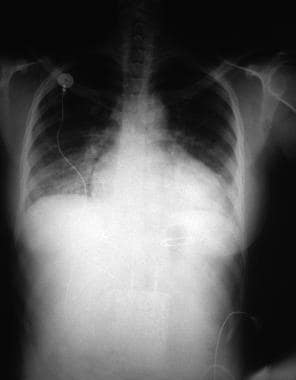Practice Essentials
High blood pressure (BP), or hypertension, is defined by two levels by 2017 American College of Cardiology/American Heart Association (ACC/AHA) guidelines
: (1) elevated BP, with a systolic pressure (SBP) between 120 and 129 mm Hg and diastolic pressure (DBP) less than 80 mm Hg, and (2) stage 1 hypertension, with an SBP of 130 to 139 mm Hg or a DBP of 80 to 89 mm Hg.
Hypertension is the most common primary diagnosis in the United States.
It affects approximately 86 million adults (≥20 years) in the United States
and is a major risk factor for stroke, myocardial infarction, vascular disease, and chronic kidney disease. See the image below.
Hypertension. Anteroposterior x-ray from a 28-year old woman who presented with congestive heart failure secondary to her chronic hypertension, or high blood pressure. The enlarged cardiac silhouette on this image is due to congestive heart failure due to the effects of chronic high blood pressure on the left ventricle. The heart then becomes enlarged, and fluid accumulates in the lungs, known as pulmonary congestion.
Signs and symptoms of hypertension
Hypertension is defined as a systolic blood pressure (SBP) of 140 mm Hg or more, or a diastolic blood pressure (DBP) of 90 mm Hg or more, or taking antihypertensive medication.
Based on recommendations of the Seventh Report of the Joint National Committee on Prevention, Detection, Evaluation, and Treatment of High Blood Pressure (JNC 7), the classification of BP for adults aged 18 years or older has been as follows
:
Normal: Systolic lower than 120 mm Hg, diastolic lower than 80 mm Hg
Prehypertension: Systolic 120-139 mm Hg, diastolic 80-89 mm Hg
Stage 1: Systolic 140-159 mm Hg, diastolic 90-99 mm Hg
Stage 2: Systolic 160 mm Hg or greater, diastolic 100 mm Hg or greater
The 2017 ACC/AHA guidelines eliminate the classification of prehypertension and divides it into two levels
:
Elevated blood pressure with a systolic pressure between 120 and 129 mm Hg and diastolic pressure less than 80 mm Hg
Stage 1 hypertension, with a systolic pressure of 130 to 139 mm Hg or a diastolic pressure of 80 to 89 mm Hg
Hypertension may be primary, which may develop as a result of environmental or genetic causes, or secondary, which has multiple etiologies, including renal, vascular, and endocrine causes. Primary or essential hypertension accounts for 90-95% of adult cases, and secondary hypertension accounts for 2-10% of cases.
See Presentation for more detail.
Diagnosis of hypertension
The evaluation of hypertension involves accurately measuring the patient’s blood pressure, performing a focused medical history and physical examination, and obtaining results of routine laboratory studies.
A 12-lead electrocardiogram should also be obtained. These steps can help determine the following
:
Presence of end-organ disease
Possible causes of hypertension
Cardiovascular risk factors
Baseline values for judging biochemical effects of therapy
Other studies may be obtained on the basis of clinical findings or in individuals with suspected secondary hypertension and/or evidence of target-organ disease, such as CBC, chest radiograph, uric acid, and urine microalbumin.
See Workup for more detail.
Management of hypertension
Many guidelines exist for the management of hypertension. Most groups, including the JNC, the American Diabetes Associate (ADA), and the American Heart Association/American Stroke Association (AHA/ASA) recommend lifestyle modification as the first step in managing hypertension.
Lifestyle modifications
JNC 7 recommendations to lower BP and decrease cardiovascular disease risk include the following, with greater results achieved when 2 or more lifestyle modifications are combined
:
Weight loss (range of approximate systolic BP reduction [SBP], 5-20 mm Hg per 10 kg)
Limit alcohol intake to no more than 1 oz (30 mL) of ethanol per day for men or 0.5 oz (15 mL) of ethanol per day for women and people of lighter weight (range of approximate SBP reduction, 2-4 mm Hg)
Reduce sodium intake to no more than 100 mmol/day (2.4 g sodium or 6 g sodium chloride; range of approximate SBP reduction, 2-8 mm Hg)
Maintain adequate intake of dietary potassium (approximately 90 mmol/day)
Maintain adequate intake of dietary calcium and magnesium for general health
Stop smoking and reduce intake of dietary saturated fat and cholesterol for overall cardiovascular health
Engage in aerobic exercise at least 30 minutes daily for most days (range of approximate SBP reduction, 4-9 mm Hg)
The AHA/ASA recommends a diet that is low in sodium, is high in potassium, and promotes the consumption of fruits, vegetables, and low-fat dairy products for reducing BP and lowering the risk of stroke. Other recommendations include increasing physical activity (30 minutes or more of moderate intensity activity on a daily basis) and losing weight (for overweight and obese persons).
The 2018 European Society of Cardiology (ESC) and the European Society of Hypertension (ESH) guidelines recommend a low-sodium diet (limited to 2 g per day) as well as reducing body-mass index (BMI) to 20-25 kg/m2 and waist circumference (to < 94 cm in men and < 80 cm in women).
Pharmacologic therapy
If lifestyle modifications are insufficient to achieve the goal BP, there are several drug options for treating and managing hypertension. Thiazide diuretics, an angiotensin-converting enzyme inhibitor (ACEI) /angiotensin receptor blocker (ARB), or calcium channel blocker (CCB) are the preferred agents in nonblack populations, whereas CCBs or thiazide diuretics are favored in black hypertensive populations.
These recommendations do not exclude the use of ACE inhibitors or ARBs in treatment of black patients, or CCBs or diuretics in non-black persons. Often, patients require several antihypertensive agents to achieve adequate BP control.
Compelling indications for specific agents include comorbidities such as heart failure, ischemic heart disease, chronic kidney disease, and diabetes. Drug intolerability or contraindications may also be factors.
The following are drug class recommendations for compelling indications based on various clinical trials
:
Heart failure: Diuretic, beta-blocker, ACE inhibitor/ARB, aldosterone antagonist
Following myocardial infarction: Beta-blocker, ACE inhibitor
Diabetes: ACE inhibitor/ARB
Chronic kidney disease: ACE inhibitor/ARB
See Treatment and Medication for more detail.

